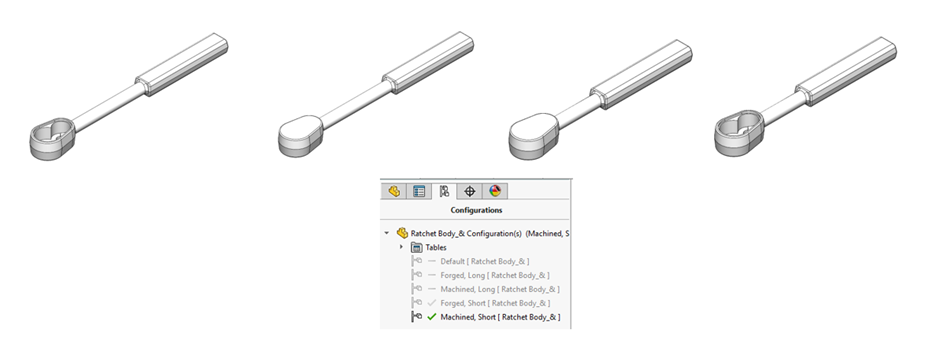Configurations in SOLIDWORKS
In the world of design, the need for multiple variations of a model often arises. This requirement extends beyond SOLIDWORKS and finds application in various scenarios, including working with Microsoft Office documents. Traditionally, managing these variations involved executing a "save as" operation to create a duplicate file, which could then be modified as required. While the "save as" command is a familiar option in SOLIDWORKS, there exists a more efficient method for handling these variations, configurations.
Understanding Configurations
In the context of SOLIDWORKS, configurations represent variations of a model stored within a single file. Instead of maintaining only one version of the model, a SOLIDWORKS file can contain an entire family of model variations. The strength of configurations lies in their ability to streamline file management. Unlike the conventional "save as" command, where each variation generates a separate file, configurations neatly organize all these variations within a single file. To seamlessly navigate through these different configurations, SOLIDWORKS provides the Configuration Manager. The power of configurations is fittingly demonstrated in toolbox components. Rather than cluttering your workspace with multiple files for each size, configurations enable you to fine-tune the component's parameters for each variant. Furthermore, in specific configurations, you can exclude certain features by specifying a suppression state.

Creating Configurations
There are essentially three methods to create configurations: manual creation within the Configuration Manager, using Configuration Tables, or employing Design Tables.
Manual Configuration Creation
The first and most straightforward method involves manually crafting a configuration within the Configuration Manager. Users can initiate either a new configuration based on the active setup or duplicate an existing configuration. This approach offers a solid foundation for comprehending how configurations function, allowing users to observe configurations being generated in the Configuration Manager
Configuration Tables
The second method revolves around Configuration Tables. These tables emerge when configuring either a feature or a sketch, prompting the automatic creation of a configuration table. With Configuration Tables, users can simultaneously craft multiple configurations based on the selected feature or sketch. Additional features can be integrated into the configuration table, and any changes made are stored within the Configuration Manager for future reference.

Design Tables
The third approach employs Design Tables. Similar to Configuration Tables, Design Tables enable users to create multiple configurations in a tabular format. However, the key distinction is that Design Tables utilize Microsoft Excel. Users can interact with the table directly within SOLIDWORKS or in a separate Microsoft Excel window. Both tables consist of rows representing each configuration of the model. Consequently, Excel must be installed to utilize this functionality. It is imperative to ensure compatibility between the versions of SOLIDWORKS and Microsoft Office. Design Tables can be auto generated and further customized using Excel features as needed.

Considerations When Working with Configurations
While configurations offer great versatility, several important considerations must be kept in mind. The performance of SOLIDWORKS can be influenced by the complexity of your model and the number of configurations it contains. In essence, configurations exist as a family within the SOLIDWORKS file, whether it's a part or an assembly. This means that all the parametric information for each configuration is stored within that single file. Consequently, when you work with the file, all this information is referenced, which can result in slower performance. Additionally, due to the inclusion of multiple configurations, the file size might be considerably larger than usual. If this becomes problematic, you can employ display states as a workaround. Display states, also accessible in the Configuration Manager, are linked to each configuration. Like configurations, they illustrate various model variations, but they only reflect graphical differences. There's no duplication of parametric data with display states.
Another potential concern is file corruption. Given that all the information resides in a single file, the risk of losing data due to file corruption exists. File corruption can occur randomly and unpredictably. One way to mitigate this risk is by using Product Data Management (PDM) systems. Although PDM doesn't make file corruption impossible, it provides the ability to revert to a previous version in case corruption does occur.
It's worth noting that the implementation of configurations can vary from one company to another. This should be considered when integrating a PDM system to ensure effective data management.
In summary, configurations in SOLIDWORKS offer a versatile toolset that can be tailored to various design needs and intentions. This article serves as an introduction to their capabilities. Below are the key advantages and challenges associated with configurations, along with strategies to address the drawbacks:
Pros of Configurations
- Model variations are captured in a single file.
- Variations can be made quickly.
- Assemblies can reference different part configurations.
- Drawings can also reference different assembly/part configurations.
- Features, sketches, maters, materials are all configurable.
- Ecel functionality can be utilized via design tables.
- Data management tools are available to accommodate configurations such as configuration-specific custom properties and other PDM tools.
Cons of Configurations
- Models with a large number of configurations can affect performance (Display states can be used as an alternative).
- Data corruption can affect all configurations (PDM can be used to revert back to a previous version; however, data corruption is random and unpredictable).
Date: 13/09/2023
